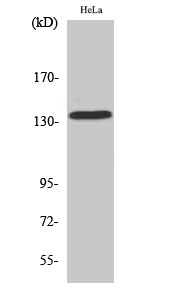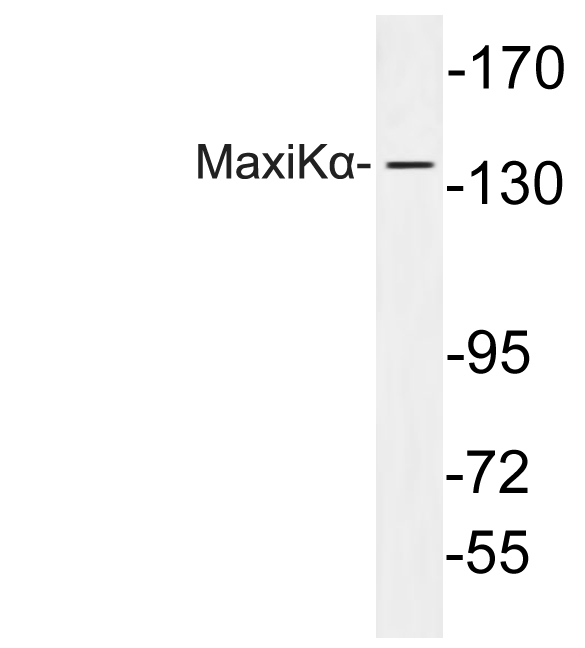MaxiKα Polyclonal Antibody
- Catalog No.:YT2666
- Applications:WB;IHC;IF;ELISA
- Reactivity:Human;Mouse;Rat
- Target:
- MaxiKα
- Fields:
- >>cGMP-PKG signaling pathway;>>Vascular smooth muscle contraction;>>Insulin secretion;>>Renin secretion;>>Salivary secretion;>>Pancreatic secretion
- Gene Name:
- KCNMA1
- Protein Name:
- Calcium-activated potassium channel subunit alpha-1
- Human Gene Id:
- 3778
- Human Swiss Prot No:
- Q12791
- Mouse Gene Id:
- 16531
- Mouse Swiss Prot No:
- Q08460
- Rat Gene Id:
- 83731
- Rat Swiss Prot No:
- Q62976
- Immunogen:
- The antiserum was produced against synthesized peptide derived from human MaxiKalpha. AA range:721-770
- Specificity:
- MaxiKα Polyclonal Antibody detects endogenous levels of MaxiKα protein.
- Formulation:
- Liquid in PBS containing 50% glycerol, 0.5% BSA and 0.02% sodium azide.
- Source:
- Polyclonal, Rabbit,IgG
- Dilution:
- WB 1:500 - 1:2000. IHC 1:100 - 1:300. ELISA: 1:40000.. IF 1:50-200
- Purification:
- The antibody was affinity-purified from rabbit antiserum by affinity-chromatography using epitope-specific immunogen.
- Concentration:
- 1 mg/ml
- Storage Stability:
- -15°C to -25°C/1 year(Do not lower than -25°C)
- Other Name:
- KCNMA1;KCNMA;SLO;Calcium-activated potassium channel subunit alpha-1;BK channel;BKCA alpha;Calcium-activated potassium channel; subfamily M subunit alpha-1;K(VCA)alpha;KCa1.1;Maxi K channel;MaxiK;Slo-alpha;Slo1;Slowpoke homolog
- Observed Band(KD):
- 137kD
- Background:
- potassium calcium-activated channel subfamily M alpha 1(KCNMA1) Homo sapiens MaxiK channels are large conductance, voltage and calcium-sensitive potassium channels which are fundamental to the control of smooth muscle tone and neuronal excitability. MaxiK channels can be formed by 2 subunits: the pore-forming alpha subunit, which is the product of this gene, and the modulatory beta subunit. Intracellular calcium regulates the physical association between the alpha and beta subunits. Alternatively spliced transcript variants encoding different isoforms have been identified. [provided by RefSeq, Jul 2008],
- Function:
- alternative products:May be partially controlled by hormonal stress. Additional isoforms seem to exist,disease:Defects in KCNMA1 are the cause of generalized epilepsy and paroxysmal dyskinesia (GEPD) [MIM:609446]. Epilepsy is one of the most common and debilitating neurological disorders. Paroxysmal dyskinesias are neurological disorders characterized by sudden, unpredictable, disabling attacks of involuntary movement often requiring life-long treatment. The coexistence of epilepsy and paroxysmal dyskinesia in the same individual or family is an increasingly recognized phenomenon. Patients manifest absence seizures, generalized tonic-clonic seizures, paroxysmal nonkinesigenic dyskinesia, involuntary dystonic or choreiform movements. Onset is usually in childhood and patients may have seizures only, dyskinesia only, or both.,domain:The calcium bowl constitutes one of the Ca(2+) sensors an
- Subcellular Location:
- Cell membrane ; Multi-pass membrane protein .
- Expression:
- Widely expressed. Except in myocytes, it is almost ubiquitously expressed.
- June 19-2018
- WESTERN IMMUNOBLOTTING PROTOCOL
- June 19-2018
- IMMUNOHISTOCHEMISTRY-PARAFFIN PROTOCOL
- June 19-2018
- IMMUNOFLUORESCENCE PROTOCOL
- September 08-2020
- FLOW-CYTOMEYRT-PROTOCOL
- May 20-2022
- Cell-Based ELISA│解您多样本WB检测之困扰
- July 13-2018
- CELL-BASED-ELISA-PROTOCOL-FOR-ACETYL-PROTEIN
- July 13-2018
- CELL-BASED-ELISA-PROTOCOL-FOR-PHOSPHO-PROTEIN
- July 13-2018
- Antibody-FAQs
- Products Images

- Western Blot analysis of various cells using MaxiKα Polyclonal Antibody

- Immunohistochemistry analysis of MaxiKα antibody in paraffin-embedded human brain tissue.

- Western blot analysis of lysate from HeLa cells, using MaxiKα antibody.



